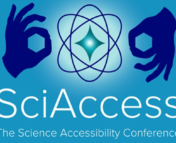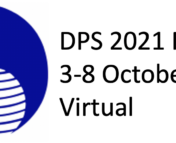This Astrobite continues our reporting on the November 2021 SciAccess Conference. In this article, we’re bringing you tips and tricks for making any poster or presentation accessible.
We’ve all had to sit through presentations filled with cluttered and confusing slides, inconsistent layouts, or terrible font choices. While this may be just an annoyance for some, it can be a formidable barrier to access for many. During the SciAccess 2021 conference, co-hosted by SciAccess (founded by Anna Voelker) and GLAS Education, we were lucky to get the chance to spend two entire sessions learning the ins and outs of creating a presentation that is accessible to all. This was made possible from an American Astronomical Society (AAS) grant that also provided free registration to the SciAccess conference for 50 AAS members who would be dedicated to showing off accessible presentation techniques at the Winter 2021 AAS conference. Though that conference was sadly canceled yesterday, we hope the invaluable tips and recommendations below are relevant to any presentation you need to give!
This session was led by Kate Meredith, President and Director of Education of GLAS, Dr. Cheryl Fogle-Hatch, founder of MuseumSenses, and Caitlyn O’Brien, an undergrad at the Ohio State University and assistant director of the conference. They emphasized in the beginning of the first session that accessibility is something that should be normalized in order to close the gap for STEM professionals with disabilities, encouraging a change in culture and not a one-off adjustment. But in order to do so, people need support and feedback, not mandates, and this workshop was designed to provide that kind of support for anyone willing to take the first step to create this cultural change.
If you’d like to follow along with the actual presentation this bite is based on, you can access the original slides at this link.
Before you begin: The Template
The first step to creating your presentation is making a template in PowerPoint. You can either start from scratch or search for templates marked as “Accessible”. Once you have a template you like, you need to head over to edit the Slide Master. Any changes you make to these master slides will propagate throughout the presentation, and it’s important for all your slide layouts to be consistent so that a screen reader can easily know where your title, subtitle, body, etc are. Some important adjustments to make are changing the font and font size and possibly adjusting the colors to allow for high contrast. Some good rules of thumb are:
- Use a minimum of 24 pt font for the titles and 18 pt for content to ensure text is large enough even for people sitting in the back of a hall to read.
- When choosing fonts, avoid Serif fonts like Garamond or Times New Roman which can make text difficult to read for people with dyslexia or a visual impairment.
- Color choice and contrast is super important both for readability and for anyone with colorblindness. The minimum brightness ratio between colors that you want to have is 4.5:1 (black and white have the highest contrast ratio at 21:1). You can easily check the contrast of your colors by using a cool web tool called Accessible Web and input the hex codes of your colors. You can also use this Color Testing site to see what all the colors in your presentation look like to a person with various degrees of colorblindness.
Once you’ve made all the changes you want to your slide master, you can save it as a template and work on the actual content of your presentation!
The Meat of Your Presentation
When creating a presentation, note that for someone who is blind or visually impaired, they might want to have a copy of your presentation so they can either use a magnifier to read your slides or use a screen reader to access the content. Screen readers aren’t perfect: they can’t just look at a complicated document or site and know the correct order to read text in and what parts it should describe. For these purposes, there are a few guidelines you can keep in the back of your mind:
- Every slide in your presentation should have a unique title so as to not confuse screen readers. Every slide also needs to have Alt Text (a short description of what’s going on in any images or plots). You can go one step further by linking to more detailed descriptions of your images (unless they’re logos, which you don’t have to describe).
- Many research talks present data in a table. If you want to do this, create simple tables within PowerPoint and assign your column and row heading the proper heading tag (don’t fake a table layout or bold text, because screen readers most likely will not read them as headings). Never paste a table or an equation as an image, since a screen reader will not be able to read the data in it.
- When using hyperlinks, don’t just put the words “link here” or “here” with the link: either put the entire URL or, ideally, describe where the link goes.
- As with tables, don’t paste images of equations, but instead use the built-in equation editor.
- Describe the axes of any graphs you put in and include alt text, but it’s always better to also provide the raw data for anyone that wants to view it in another way (like through sonification, which I talk about in this bite).
All of these guidelines might seem quite daunting, but there are ways to check if there’s anything left in your PowerPoint that might need adjusting. Once you have all the content in your presentation, you can go to Review→Check Accessibility, which will inspect your presentation and tell you if you’re missing anything like alt text or slide titles.
Reading Order
Once you’ve fixed any errors the checker throws at you, the last change you’ll want to make is the order in which a screen reader will read out text and image descriptions. This can be done by going to Arrange→Selection Pane. This brings up a list of all the elements on your slide, with names like “Picture 2”, “Subtitle 1”, “Slide Number Placeholder 3”. Screen readers will read the content and alt text of these elements from bottom to top (!), so check to make sure everything is in a logical order. Sometimes, you might not want to have a certain element read by the screen reader (if you have the same logo on each slide, for example). You can mark these elements as “decorative” by right clicking on them, opening the Alt Text pane, and checkboxing “Mark as decorative”.
Congratulations! You have now created an accessible presentation. The last step to ensure readability is to hit “Create and Share Adobe PDF”. This will export your presentation to a pdf that will play nice with screen readers. DO NOT hit Print->Save as PDF, as this can mess up image placement and reading order.
Closing Remarks
As the accessible poster-making session wrapped up, Kate, Cheryl, and Caitlyn gave us some invaluable tips on presenting in an accessible way. As Kate was going through the slides, she read each slide number out loud so everyone knew where exactly she was in the presentation and made an effort to not only describe any visuals or text on her slides, but also herself as a presenter. You don’t need to go into too much detail, but telling the audience your name, pronouns, and general physical appearance (what color clothes you’re wearing for example) gives anyone who is visually impaired a mental image behind the voice that is talking. If you’re giving a talk in person, don’t hide behind the podium, and speak at a normal pace to give the audience time to process–don’t rush through to fit in 25 slides in 5 minutes. Another tip was to have a large, high-contrast QR code available in the beginning of your talk or on your poster so attendees can download a copy of your slides or poster to follow along if they wish (you can use a simple QR maker like this). Having tactile graphics or models that relate to your work is another great way to engage your audience and also give visually impaired attendees another mode by which to learn about your work.
If you have any questions about creating your accessible posters or presentations, you can contact Kate Meredith and GLAS at [email protected] with any questions you might have!
Disclaimer: The author has been a long-time volunteer and contractor for GLAS Education.
Astrobite edited by Briley Lewis
Featured image credit: Instagram/@nasahubble



